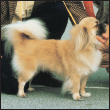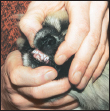Physical Characteristics of the Tibetan Spaniel
(from the American Kennel Club breed standard)
Neck: Moderately short, strong and well set on.
Skull: Slightly domed, moderate width and length.
Head: Small in proportion to body and proudly carried, giving an impression of quality. Masculine in dogs but free from coarseness.

Ears: Medium size, pendant, well feathered in the adult and set fairly high. They may have a slight lift from the skull, but should not fly.
Eyes: Dark brown in color, oval in shape, bright and expressive, of medium size set fairly well apart but forward looking, giving an apelike expression. Eye rims black.
Nose: Black.
Muzzle: Medium length, blunt with cushioning, free from wrinkle.
Teeth: Evenly placed and the lower jaw wide between the canine tusks. Full dentition desired. A level mouth is permissible, providing there is sufficient width and depth of chin to preserve the blunt appearance of the muzzle.
Forequarters: Shoulder well placed. The bones of the forelegs slightly bowed but firm at shoulder. Moderate bone.
Tail: Set high, richly plumed and carried in a gay curl over the back when moving.
Hindquarters: Well made and strong. Stifle well developed, showing moderate angulation. Hocks well let down and straight when viewed from behind.
Coat: Double coat, silky in texture, smooth on face and front of legs, of moderate length on body, but lying rather flat. Ears and back of forelegs nicely feathered, tail and buttocks well furnished with longer hair. Neck covered with a mane or shawl of longer hair, which is more pronounced in dogs than bitches. Feathering between toes often extending beyond the feet.
Color: All colors, and mixtures of colors allowed. FeetWhite markings allowed.
Size: Height about 10 inches.
Weight: 9-15 pounds being ideal.
Contents

Travel to the high tablelands of Tibet to discover the fascinating origins of the Tibetan Spaniel , a dog prized by the Buddhists and the Dalai Lama himself. Meet the movers and shakers who promoted the breed outside its homeland and see how the Tibetan Spaniel has become recognized around the world.

Find out about the Tibbies charming personality and the many other traits that endear this dignified breed to fanciers. Read about the breeds physical characteristics and health considerations, and learn why the Tibetan Spaniel excels as a superlative companion animal.

Learn the requirements of a well-bred Tibetan Spaniel by studying the description of the breed set forth in the American Kennel Club standard. Both show dogs and pets must possess key characteristics as outlined in the breed standard.

Find out about how to locate a well-bred Tibetan Spaniel puppy. Discover which questions to ask the breeder and what to expect when visiting the litter. Prepare for your puppy-accessory shopping spree. Also discussed are home safety, the first trip to the vet, socialization and solving basic puppy problems.

Cover the specifics of taking care of your Tibetan Spaniel every day: feeding for the puppy, adult and senior dog; grooming, including coat care, ears, eyes, nails and bathing; and exercise needs for your dog. Also discussed are the essentials of dog identification.

Begin with the basics of training the puppy and adult dog. Learn the principles of house-training the Tibetan Spaniel , including the use of crates and basic scent instincts. Enter puppy kindergarten and introduce the pup to his collar and leash, and progress to the basic commands. Find out about obedience classes and other activities.

By Lowell Ackerman DVM, DACVD
Become your dogs healthcare advocate and a well-educated canine keeper. Select a skilled and able veterinarian. Discuss pet insurance, vaccinations and infectious diseases, the neuter/spay decision and a sensible, effective plan for parasite control, including fleas, ticks and worms.

Step into the center ring and find out about the world of showing pure-bred dogs. Heres how to get started in AKC shows, how they are organized and whats required for your dog to become a champion. Take a leap into the realms of obedience trials and agility.
KENNEL CLUB BOOKS TIBETAN SPANIEL
ISBN 13: 978-1-59378-312-9
eISBN 13: 978-1-62187-002-9
Copyright 2006 Kennel Club Books An Imprint of I-5 Press A Division of I-5 Publishing, LLC
3 Burroughs, Irvine, CA 92618 USA
Cover Design Patented: US 6,435,559 B2 Printed in South Korea
All rights reserved. No part of this book may be reproduced in any form, by photostat, scanner, microfilm, xerography or any other means, or incorporated into any information retrieval system, electronic or mechanical, without the written permission of the copyright owner.
10 9 8 7 6 5 4 3 2 1
Photography by Carol Ann Johnson
with additional photographs by:
Arooo! Photography by Mark Gilliland, Paulette Braun, T.J. Calhoun, Gary A. Depp, Don Finney, Isabelle Franis, Bill Jonas, Susan Miccio and SpotShots by Doug DuKane.
Illustrations by Rene Low and Patricia Peters.
The publisher wishes to acknowledge the invaluable assistance of Mallory Driskill, Harold Hartman, Susan Miccio and Herb Rosen in compiling the American section of this book.

From the high tablelands of Tibet comes the Tibetan Spaniel, a quaint Oriental breed that has a fascinating history. These two youngsters are Haborn Sherpa Chumbo (left) and his litter sister Haborn Sherpanie for Braeduke at nine months of age.

ORIGIN OF THE BREED
The Tibetan Spaniel is a small, active and alert little dog that hails from the high tablelands of Tibet, known frequently as the Roof of the World. This is a mystical country with a barren landscape. Tibets dogs, like its people, have to be able to deal with extremes of temperature, fiercely bright light and high altitude, for the majority live between 10,000 and 17,000 feet.
Next page



























